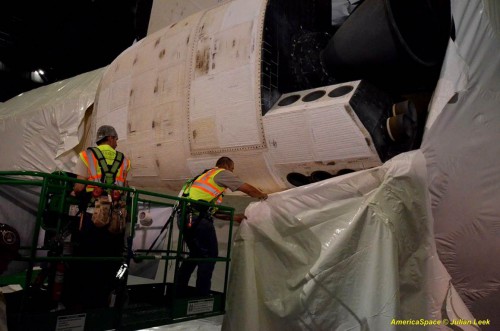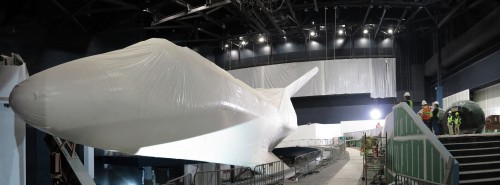
CAPE CANAVERAL, Fla — The Kennedy Space Center Visitor Complex began unwrapping a very special Space Coast present yesterday—Space Shuttle Atlantis. Starting yesterday morning, Atlantis began having the protective cover that has shielded her removed, as the construction of her new $100 million home was completed. Using an abundance of caution, the new caretakers of this priceless artifact, Delaware North Companies (DNC), who operates the Kennedy Space Center Visitor Complex for NASA, have opted to stretch what had been a one-day process to a two-day affair.
The unwrapping took place in stages, with the plastic (essentially what is used to protect boats as they are moved) being cut by a tool resembling an emergency seat belt cutter. Pains were taken to make sure that no damage occurred during this procedure.

After being cut, the plastic is allowed to fall free to the floor below. The exception being the aft (tail) section of the orbiter, which, due to the tail fin and Orbiter Maneuvering System (OMS) pods, requires a slightly more involved procedure to remove the plastic wrap.
After the 16 mil plastic is removed, it will be recycled. After this delicate procedure is completed, the next major task is to open the payload doors. These doors are not designed to be opened on Earth and therefore must be supported by “strong backs.” The sight is striking, with Atlantis at an angle; guests will see her as only astronauts have seen her before. Currently Atlantis’ new digs are slated to open June 29 of this year.

Displaying Atlantis in this manner has never been done before, so those working on the project are keen to take their time and get it right the first time. Former United Space Alliance employees have been hired to do a number of the tasks to display the orbiter. For those who have had Atlantis placed in their care, the obligation they are most focused on is making sure that the shuttle’s history is properly chronicled.
“There are a variety of stories to tell, and it’s our responsibility to see to it that this is done properly,” said Delaware North Companies Director of Project Development Tim Macy. “This is one of the most awesome things ever built; it was built in the USA, and we want to get it across to the public that the American space program is alive.”

The structure that will house Atlantis has numerous elements that are subtle and, in some cases, not-so-subtle references to the shuttle era. The mottled gray exterior is meant to evoke the heat shield tiles (complete with the leading edge reinforced carbon carbon tiles) that allowed the shuttles to safely reenter the Earth’s atmosphere. A large, orange arc sits outside; this object, which appears at first glance to be merely a piece of ornamental art, is actually an abstract representation of the fiery contrail that accompanied the shuttles in their 134 successful trips back to Earth.
No tax dollars are tapped to operate either the Visitor Complex or construct this new facility. Revenue is generated through ticket and other sales at the Visitor Complex.

Atlantis’ new home will incorporate numerous simulators that will allow guests to develop a better understanding and appreciation of the space shuttle program. The gaseous vent arm, or “beanie cap,” from Launch Complex 39B that rested atop the shuttle’s large, orange external tank during the lead up to launch will be part of the exhibit, as will a life-sized model of the Hubble Space Telescope. Models of the shuttle’s Solid Rocket Boosters and External Tank will serve as the gateway into the new structure, providing guests with a view that astronauts, space workers, and few others have had before.

According to DNC representatives, this project is both on time and within budget.
The care taken with Atlantis stands in contrast to how the flight test article of the shuttle program, Enterprise, has been cared for to date. During her transportation to the Intrepid Sea, Air, and Space Museum, Enterprise’s right wing was dragged along the side of a bridge, tearing the tip of the right wing. The test article was then placed in an inflatable structure, which deflated during a power outage caused by Hurricane Sandy. This left Enterprise exposed to the elements and caused the tail and other parts of the shuttle to be damaged.
Atlantis’ two surviving sisters, Discovery and Endeavour, have reached their final destinations—the Smithsonian’s Steven F. Udvar-Hazy Center and The California Science Center, respectively. Discovery resides in the spot once held by Enterprise, and Endeavour is in a temporary structure while she awaits the construction of her permanent home.

For Macy’s part, he is relieved that he and his team have done things in the manner that they have.
“I’m really happy that we did this the right way—that we didn’t rush—despite the fact that we had a long and aggressive schedule ahead of us,” he said as another section of Atlantis was revealed.
[youtube_video]http://youtu.be/44EGRK__z-k[/youtube_video]
Video courtesy of the Kennedy Space Center Visitor Complex
Want to keep up-to-date with all things space? Be sure to “Like” AmericaSpace on Facebook and follow us on Twitter:@AmericaSpace




This article was a DELIGHT to read….great pics & a VIDEO too! Very INFORMATIVE….loved the mention that TAX DOLLARS were not used to bring this magnificent exhibit to the public. As one who HAS seen Endeavour in Los Angeles….I can only say that it IT IS A THRILL YOU CANNOT IMAGINE…UNTIL YOU HAVE SEEN ONE OF THESE MAGNIFICENT MACHINES YOURSELF…!!!
Thanks for a great article!!
As a teenager Diamond worked on a farm alongside a Native American who exhibited very admirable values and work ethics, unlike the coarse white miners. This is when Diamond really learned the Native Americans perspective on the white man’s conquest. “Food production was indirectly a prerequisite for the development of guns, germs, and steel. This chapter traces the http://www.youtube.com/watch?v=Mj8o3vBS7p8 main connections through which food production led to advantages.” The 1st is that “availability of more consumable calories means more people” = strength of http://www.youtube.com/watch?v=COoSZZ-zwfQ numbers. Domestic animals/livestock fed people by furnishing meat, milk, and fertilizer and by animal labor. Full time specialists first appeared in sedentary societies. Two types of specialists came about, the kings and bureaucrats. Hunter-gatherers didn’t have these and were egalitarian. Animals and crops also provide warmth and tools. The animals were http://www.youtube.com/watch?v=WfIiZU-HRRw also used as the main transport. Eurasia used horses in warfare. This http://www.youtube.com/watch?v=KG6P3fT4IuU was the most direct contribution of animal domestication to wars. Germs also evolved in societies with domestic animals such as small pox, measles, and flu.